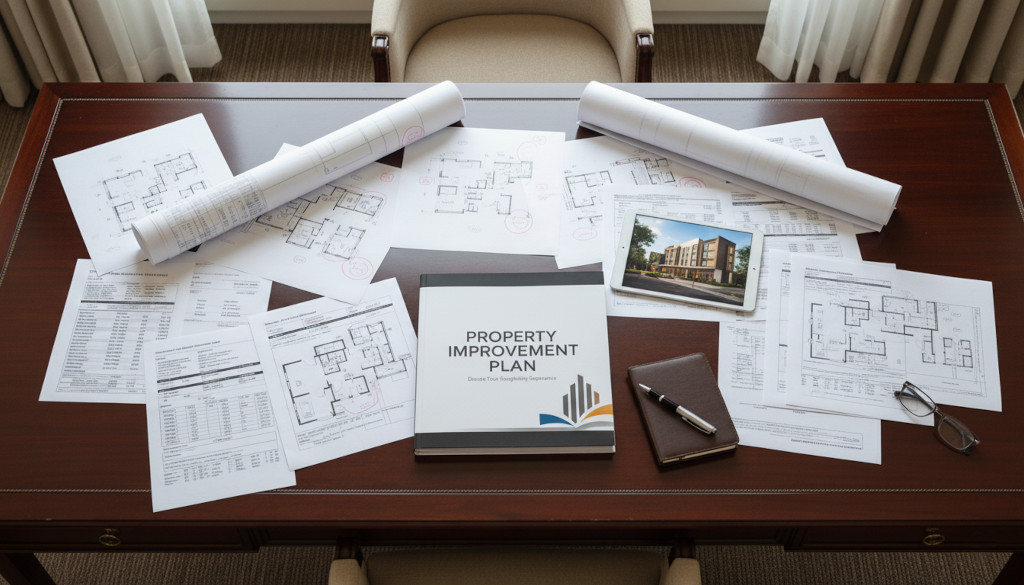Hotel PIP Compliance: Turn Upgrades Into Revenue Opportunities

Turn Your PIP Into a Win: Expert Tips for Smooth Renovations
Hotel renovations are stressful. Add a Property Improvement Plan (PIP) into the mix, and it can feel like juggling fire while walking a tightrope. According to industry data, 68% of hotel owners report PIP compliance as their top operational challenge, with budget overruns and guest disruption being the main concerns. But it doesn't have to be that way. Done smartly, a PIP can become an opportunity to refresh your property, impress guests, and boost your revenue by 15-25% within the first year.
Here's a practical guide that owners and managers can actually use.
What Exactly Is a PIP?
A Property Improvement Plan (PIP) is a roadmap from your hotel brand, listing upgrades your property must complete to maintain franchise standards. Most brands require PIP updates every 5-7 years, though some items may be flagged during annual inspections.
Think of it as a brand checklist that ensures every hotel looks and feels consistent with their standards, protecting both the brand's reputation and your property's market position.
- Operating cash reserves
- SBA 7(a) or 504 loans
- Franchisor financing programs (some brands offer preferential rates)
- Equipment leasing for FF&E
- Partnering with renovation contractors who offer flexible payment terms
- Refinancing existing debt to access equity
Typical PIP Requirements Include:
- Guest room upgrades: Furniture, lighting, flooring, and finishes
- Bathroom renovations: Plumbing, fixtures, vanities, and accessibility features
- Lobby and public spaces: Seating, lighting, finishes, and brand-compliant design
- Safety and compliance: ADA requirements, fire safety systems, and building codes
- Technology updates: Wi-Fi infrastructure, smart room controls, and booking systems
- Sustainability improvements: Energy-efficient HVAC, LED lighting, and water conservation
The goal? Keep your hotel competitive, compliant, and guest-ready while protecting your franchise agreement.
The Challenges Hotel Owners Face
If you've ever had to handle a PIP, you know the hurdles:
- Tight timelines with minimal disruption to guests and revenue
- Unclear scope or conflicting priorities between brand requirements and budget reality
- Contractors unfamiliar with brand standards who miss critical compliance details
- Hidden costs that surprise you mid-project (asbestos, plumbing, code updates)
- Financing pressure when capital isn't readily available
- Guest experience concerns during construction
All of these can make even a small renovation feel overwhelming, but a good plan changes everything.
For common mistakes to avoid during hotel renovations, check out our article Top 5 Mistakes Hotel Owners Make During Renovations.
Typical PIP Timeline: What to Expect
Understanding the process helps you plan better:
Months 1-3: PIP notification and scope review with brand representative
Months 4-6: Contractor selection, detailed planning, and permit applications
Months 7-12: Phased renovation execution with minimal guest disruption
Months 13-15: Final inspections, punch-list completion, and brand approval
Most PIPs require completion within 12-18 months of notification, though extensions may be possible with proper documentation and justified reasons (major renovations, supply chain issues, etc.).
Pro Tip: Start planning immediately upon PIP notification. The longer you wait, the more rushed and expensive the project becomes.
How to Approach PIP Compliance Like a Pro
1. Start Planning Early
The sooner you start, the smoother it will go. Ideally, begin 12–18 months before your PIP deadline.
- Review your brand’s PIP carefully
- Identify must-do items versus optional upgrades
- Prioritize changes with the highest impact on guests and revenue
2. Choose a Contractor Who Gets Hotels
Not every builder knows what running a hotel is like. You need someone who:
- Has a proven record with hotel renovations
- Understands brand and franchise standards
- Can coordinate with staff to reduce guest disruption
At Liberty Way Renovation, we specialize exclusively in hospitality projects, balancing timing, quality, and guest comfort.
3. Budget Transparently
Don’t wait for surprises. Ask your contractor for:
- Itemized estimates with clear line items
- A 10–15% contingency for unexpected costs
- Regular updates so you know exactly where your money is going
4. Protect Your Guests
Guests don’t take a vacation break just because your rooms are being renovated.
- Use phased renovations (floor by floor or wing by wing)
- Keep noisy work to low-occupancy times
- Communicate with staff and guests so nobody is caught off guard
5. Think of PIP as a Growth Opportunity
Instead of seeing it as a burden, treat your PIP like a chance to upgrade your hotel for the future and outpace local competition.
Strategic upgrade opportunities:
- Energy-efficient lighting and HVAC reduce utility costs by 20-30%
- Smart technology for guest convenience (keyless entry, smart thermostats, voice controls)
- Durable, low-maintenance materials that reduce long-term costs
- Enhanced accessibility features that expand your market
- Modern design elements that command higher ADR
- Sustainability features that appeal to eco-conscious travelers
ROI perspective: Hotels that complete PIPs strategically see average revenue increases of 15-25% within 12 months, plus improved guest satisfaction scores and online reviews. Check out our detailed guide on why renovating now boosts ROI for hotel owners.
Turning Compliance Into Value
Following these steps doesn’t just help you check boxes, it increases your property value, guest satisfaction, and long-term revenue. PIP compliance done right is an investment, not a cost.
Need Help Navigating Your PIP?
The longer you wait, the more rushed (and expensive) the project becomes. Most successful PIP renovations start planning 12-18 months before the deadline. At Liberty Way Renovation, we help hotel owners across the USA complete brand-approved renovations on time, on budget, and without disrupting guests.
Call +1 229 444-9535 or send your PIP to office@lwrenovate.com to start planning your next renovation today.